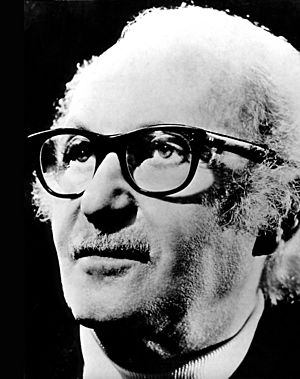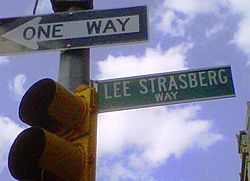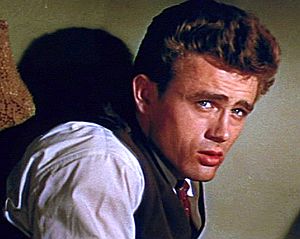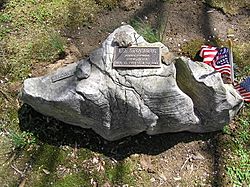Lee Strasberg facts for kids
Quick facts for kids
Lee Strasberg
|
|
|---|---|

Strasberg in 1976
|
|
| Born |
Israel Strassberg
November 17, 1901 Budzanów, Kingdom of Galicia and Lodomeria, Austria-Hungary (now Budaniv, Ternopil Oblast, Ukraine)
|
| Died | February 17, 1982 (aged 80) New York City, U.S.
|
| Resting place | Westchester Hills Cemetery |
| Nationality | American |
| Occupation |
|
| Years active | 1925–1982 |
| Known for |
|
| Spouse(s) |
|
| Children | 4, including Susan and John |
Lee Strasberg (born Israel Strassberg; November 17, 1901 – February 17, 1982) was an American theatre director, actor, and acting teacher. He is famous for developing and teaching "method acting" in America. This way of acting helps actors create very real and deep performances.
In 1931, he helped start the Group Theatre in New York City. This was a new kind of theatre group, called "America's first true theatrical collective." Later, in 1951, he became the director of the Actors Studio. This school is known as "the nation's most prestigious acting school." Many famous actors learned from him there.
Lee Strasberg taught many well-known actors. These include Anne Bancroft, Dustin Hoffman, James Dean, Marilyn Monroe, Jane Fonda, Paul Newman, Al Pacino, and Robert De Niro. He helped them bring their characters to life in a powerful way.
In 1970, he opened the Lee Strasberg Theatre and Film Institute. This school continued his teaching methods in New York City and Hollywood. As an actor, Strasberg is best known for playing the character Hyman Roth in the movie The Godfather Part II (1974). He was even nominated for an Academy Award for Best Supporting Actor for this role.
Lee Strasberg's Early Life
Lee Strasberg was born Israel Strassberg in Budzanów, which was part of Austria-Hungary (now Ukraine). His parents were Jewish. His father moved to New York City first. Later, in 1909, the whole family came together in New York. They lived on the Lower East Side of Manhattan.
Young Strasberg loved to read. He was very close to his older brother, Zalmon. When Zalmon died in the 1918 influenza pandemic, it was very hard for Lee. Even though he was a great student, he dropped out of high school.
A relative helped him get a small part in a Yiddish-language play. He then joined a drama club. A casting director named Philip Loeb saw that Strasberg had acting talent. At 23, he joined the Clare Tree Major School of the Theater. He became a U.S. citizen in 1939.
Becoming a Famous Acting Teacher
Strasberg left the Clare Tree Major School to learn from students of Konstantin Stanislavski. These teachers were Maria Ouspenskaya and Richard Boleslawski at the American Laboratory Theatre. In 1925, Strasberg acted professionally for the first time in a play called Processional.
The Group Theatre
Lee Strasberg became well-known at the Theater Guild of New York. In 1931, he helped create the Group Theatre in New York. Here, he developed his special acting technique, known as "The Method" or "Method Acting."
His teaching ideas came from the Russian theatre expert, Konstantin Stanislavski. Stanislavski's book, An Actor Prepares, talked about how actors can understand their characters' feelings. Strasberg started as a director, but he spent more and more time training actors. The Group Theatre was known for staging plays that dealt with important social issues.
Famous members included Harold Clurman, Clifford Odets, and Elia Kazan. Playwright Arthur Miller said the Group Theatre was "the voice of Depression America." Strasberg left the Group Theatre in 1937.
The Actors Studio
In 1947, Elia Kazan, Robert Lewis, and Cheryl Crawford, who were also from the Group Theatre, started the Actors Studio. It was a workshop for actors to work on their skills without the pressure of commercial theatre. In 1951, Lee Strasberg became its artistic director.
He changed how American actors were trained. Many amazing performers learned from him, like Marilyn Monroe, Julie Harris, Paul Newman, and Al Pacino. The Actors Studio was a private place where actors could explore their craft. Strasberg said, "At the studio, we do not sit around and feed each other's egos. People are shocked how severe we are on each other."
Getting into the Actors Studio was very hard. More than a thousand actors tried out each year, but only five or six were accepted. Jack Nicholson auditioned five times before he got in. Dustin Hoffman tried six times, and Harvey Keitel, 11 times.
- Al Pacino: He said, "The Actors Studio meant so much to me in my life. It really did. That was a remarkable turning point in my life."
- James Dean: He called the studio "The greatest school of the theater." He was proud to be one of the youngest members.
- Marilyn Monroe: She became a serious student of Lee Strasberg. She studied acting deeply and read many good books.
- Jane Fonda: She said meeting Lee Strasberg changed her life. He told her she had "real talent," which was a big turning point for her.
Strasberg's Teaching Style
Strasberg's teaching focused on two main things: improvisation and "affective memory." Improvisation means making things up on the spot. Affective memory means using your own past feelings and experiences to understand and show a character's emotions.
He wanted actors to be very disciplined and to find deep, true feelings for their roles. When preparing for a part, Strasberg asked actors to think about the character's life before the play even started. This could go all the way back to their childhood. He believed the play was the most important part of the character's life.
Famous Students and Their Stories
James Dean
James Dean was a student of Strasberg. He died in a car accident in 1955 at age 24. Strasberg talked about Dean in a lecture shortly after his death.
Marilyn Monroe
In 1962, Marilyn Monroe died at age 36. She was very famous at that time. Lee Strasberg gave a speech at her funeral.
Personal Life
Lee Strasberg was married three times. His first wife, Nora Krecaum, died in 1929. In 1934, he married actress Paula Miller. They had two children, Susan and John. Paula died in 1966. His third wife was Anna Mizrahi. They had two sons, Adam and David.
Death and Remembering Lee Strasberg
Lee Strasberg passed away from a heart attack on February 17, 1982, in New York City. He was 80 years old. He was buried at Westchester Hills Cemetery in New York. Just a day before he died, he learned he had been chosen for the American Theater Hall of Fame.
His last public appearance was on February 14, 1982, at a big show called Night of 100 Stars. He even danced with The Rockettes alongside Al Pacino and Robert De Niro. Friends said he was healthy until the day he died. Al Pacino said, "What stood out was how youthful he was. He never seemed as old as his years. He was an inspiration." Jane Fonda said she might not have become an actress without him.
Lee Strasberg's Legacy

Lee Strasberg's teaching helped create a new kind of male movie star. These actors often played "rebel heroes." Their acting felt very real and deep, showing inner struggles. This style of acting, which Strasberg spent his life exploring, made performances seem very natural and powerful.
In 2012, Strasberg's family gave his personal papers to the Library of Congress. These papers include many letters, notes, photos, and drawings about theatre.
Lee Strasberg and his family appear as characters in a play called Nobody Dies on Friday. This play was written by Robert Brustein in 1998.
In 2020, Google Arts & Culture and an Italian actor named Giovanni Morassutti created an online exhibit. It is called Strasberg Legacy and shows the history of realistic acting.
Broadway Plays Lee Strasberg Worked On
- Four Walls (1927) – actor
- The Vegetable (1929) – director
- Red Rust (1929) – actor
- Green Grow the Lilacs (1931) – actor
- The House of Connelly (1931) – co-director
- 1931 (1931) – director
- Success Story (1932) – director
- Men in White (1933) – director
- Gentlewoman (1934) – director
- Gold Eagle Guy (1934) – director
- Paradise Lost (1935) – produced by Group Theatre
- Case of Clyde Griffiths (1936) – director, produced by Group Theatre
- Johnny Johnson (1936) – director, produced by Group Theatre
- Many Mansions (1937) – director
- Golden Boy (1937) – produced by Group Theatre
- Roosty (1938) – director
- Casey Jones (1938) – produced by Group Theatre
- All the Living (1938) – director
- Dance Night (1938) – director
- Rocket exhibitionn (1938) – produced by Group Theatre
- The Gentle People (1939) – produced by Group Theatre
- Awake and Sing! (1939), revival – produced by Group Theatre
- Summer Night (1939) – director
- Night Music (1940) – produced by Group Theatre
- The Fifth Column (1940) – director
- Clash by Night (1941) – director
- A Kiss for Cinderella (1942), revival – director
- R.U.R. (Rossum's Universal Robots) (1942), revival – director
- Apology (1943) – producer and director
- South Pacific (1943) – director
- Skipper Next to God (1948) – director
- The Big Knife (1949) – director
- The Closing Door (1949) – director
- The Country Girl (1950) – co-producer
- Peer Gynt (1951), revival – director
- Strange Interlude (1963), revival – produced by The Actors Studio
- Marathon '33 (1963) – production supervisor
- Three Sisters (1964), revival – director, produced by the Actors Studio
Movies Lee Strasberg Acted In
- China Venture (1953) as Patterson
- The Godfather Part II (1974) as Hyman Roth
- The Cassandra Crossing (1977) as Herman Kaplan
- The Last Tenant (1978, TV movie)
- ...And Justice for All. (1979) as Sam Kirkland
- Boardwalk (1979) as David Rosen
- Going in Style (1979) as Willie
- Skokie (1981, TV movie) as Morton Weisman
See also
 In Spanish: Lee Strasberg para niños
In Spanish: Lee Strasberg para niños
- Method acting
- Konstantin Stanislavski
- Famous students of the Lee Strasberg Institute
- Marilyn Monroe
- Stella Adler



